In the fiscal year ended March 31, 2024, uncertainty prevailed in the economic climate due to a sluggish Chinese economy and trade issues between the U.S. and China amid further instability in the global environment. The Japanese economy, on the other hand, showed signs of gradual recovery, with personal consumption picking up despite rising prices and a
depreciating yen.
The electronics industry, to which the KAGA ELECTRONICS GROUP belongs, saw continued demand growth in the automotive market as the global shortage of semiconductor and electronic components eased while other sectors, such as the industrial equipment market, lingered in an adjustment phase. Under such circumstances, the Electronics components business was affected by the disappearance of spot demand due to the easing of supply shortages of semiconductors and electronic components, the curtailment of transactions with specific consumers at an overseas subsidiary of EXCEL CO., LTD., and inventory adjustments that began in earnest in the third quarter and thereafter. Reflecting these conditions, net sales decreased year on year by 10.8% to ¥542,697 million.
Operating income fell 19.9% to ¥25,845 million and ordinary income fell 20.7% to ¥25,976 million as a result of efforts to reduce selling, general and administrative expenses in response to the decline in gross profit on sales caused by the decrease in net sales. Profit attributable to owners of the parent fell 11.8% year on year to ¥20,345 million, due in part to extraordinary gains on sales of investment securities and a gain on bargain purchase associated with a corporate acquisition.
For the fiscal year ended March 31, 2024, we started with a year-on-year forecast of lower sales and profits, based on the assumption that the electronic components business
will be affected by two factors: inventory adjustments among consumers due to the easing supply and demand for semiconductors and electronic components, and the absence of spot demand, which contributed to earnings growth in the previous two fiscal years. Reflecting on the past year, the absence of spot demand was as expected, but the impact of inventory adjustments did not materialize as expected in the fiscal year’s first half, resulting in net sales and operating income both exceeding the internal plan. In the second half of the fiscal year, however, the impact of inventory adjustments finally began to take hold, and as a result, the upward swing in operating income gradually narrowed.
In the end, the Company exceeded its initial forecast and generally achieved a solid landing.
Investor RelationsInvestor Relations

- IR
- IR Library
- Integrated Report (Message from the COO)
Integrated Report (Message from the COO)
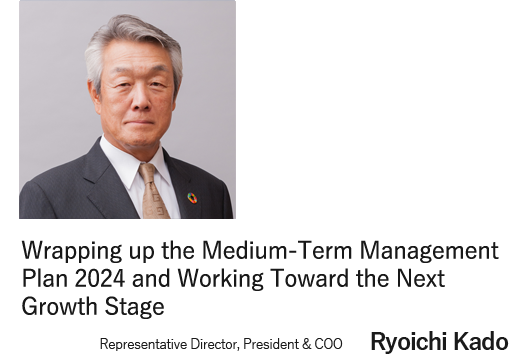
The electronics related market is expected to expand over the medium to long term, particularly for automotive applications. However, customers are expected to continue engaging in inventory adjustments for the time being, with a full recovery in demand expected to not begin until the second half of the fiscal year ending March 31, 2025. In addition, the Group has implemented a wage increase effective April 2024 as an investment in human capital that will contribute to future growth.
Based on these circumstances, for the fiscal year ending March 31, 2025, we forecast net sales of ¥555.0 billion, operating income and ordinary income of ¥26.0 billion, and profit attributable to owners of the parent of ¥18.0 billion. While the wage increase will drive up expenses by approximately ¥1.5 billion, even after factoring in the impact of this increase, we hope to make the current fiscal year one in which we can return to a growth trend in terms of both sales and profits.
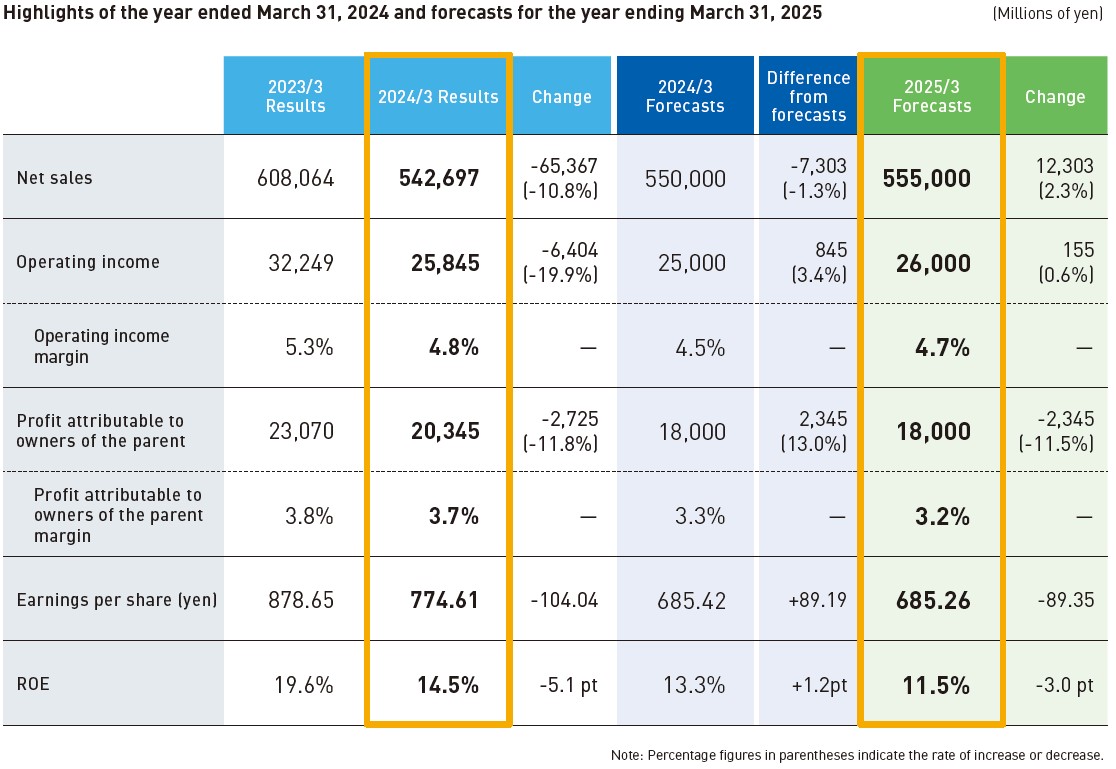
The Company is scheduled to execute a stock split effective October 1, 2024. With the date of record set at September 30, the Company will conduct a 2-for-1 stock split of its common stock in order to create an environment that makes it easier for individual investors to invest by reducing the minimum investment unit while increasing the liquidity of the Company’s stock and further expanding its investor base. The year-end dividend for March 2025 will be ¥55 per share as a result of this stock split, but there will be no substantial change in the dividend, as it will be implemented in accordance with the split ratio.

The Company’s policy on shareholder returns is to maintain stable dividends while targeting a consolidated payout ratio of 25% to 35%. Although profits declined in the fiscal year ended March 31, 2024, we resolved to pay out a dividend of ¥220 per share, the same amount as the previous year, in line with this policy. In the fiscal year ending March 31, 2025, despite our anticipating a decrease in profit, the dividend is expected to be ¥220 (before the stock split).
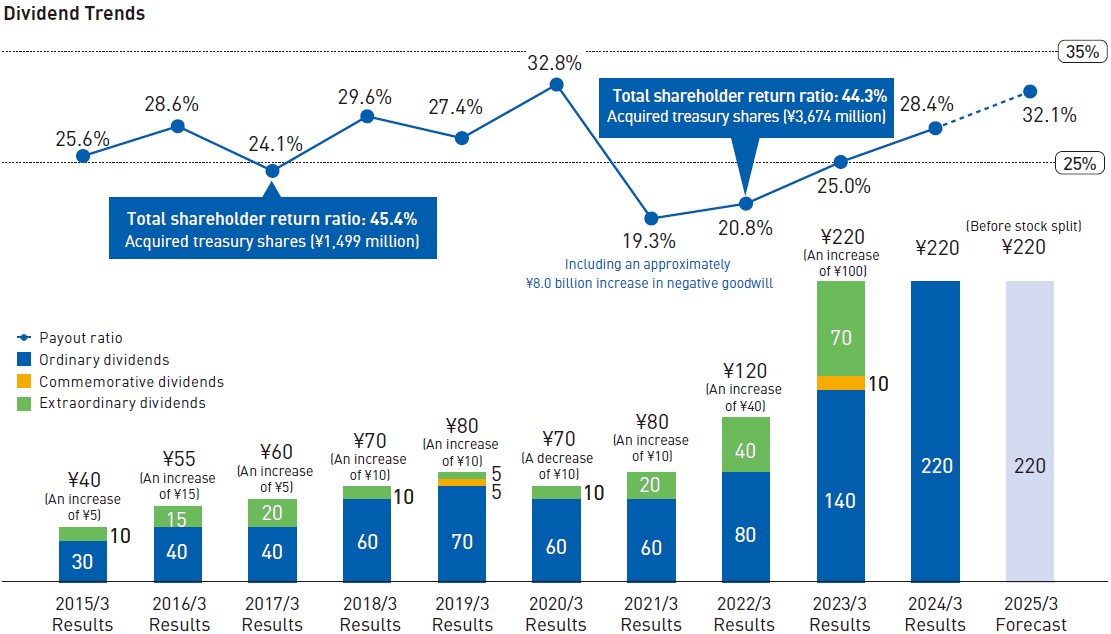
On January 25, 2024, the Company decided on a policy to address the cost of capital and improve stock price awareness. With the goal of ensuring continued improvement in ROE by achieving profitability that exceeds the cost of shareholders’ equity as well as of ensuring improvement in its price-to-book ratio by securing fair evaluations from the stock market for its business and growth potential, the Company will steadily implement various measures set forth in its Medium-Term Management Plan 2024 with a focus on the following four items.
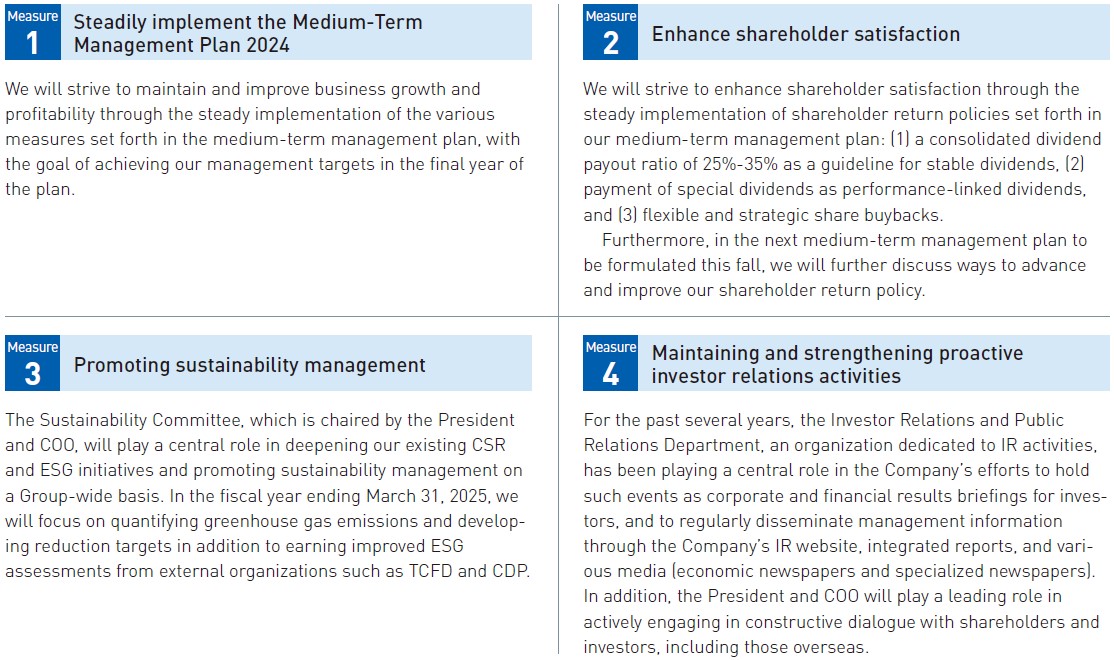
In November 2021, the Company announced its threeyear Medium-Term Management Plan 2024. During the fiscal year ended March 31, 2023, the plan’s first year, the Company achieved its KPI targets for net sales, operating income, and ROE (excluding new M&A targets) two years ahead of schedule, as a result of proactively addressing spot demand by maximizing the strength of the Company’s procurement capabilities amid the ongoing global shortage of semiconductors and electronic components.
On May 11, 2024, we announced the latest outlook, updating our final-year forecast in light of these firstyear results. In terms of results for the fiscal year ended March 31, 2024, operating income and ROE to exceeded the initial plan due to changes in the environment, including the absence of spot demand in the electronic components business, customer engagement in prolonged inventory adjustments, and wage hikes. However, net sales and operating income are still at a level below the latest forecast regarding the plan’s management targets.
For the fiscal year ending March 31, 2025, we have positioned the earnings forecast announced on May 9, 2024, as a “commitment” to our stakeholders and the latest forecast as a “challenge target,” and the entire Group is united in its efforts to wrap up the Medium-Term Management Plan 2024 on a high note in its final year.
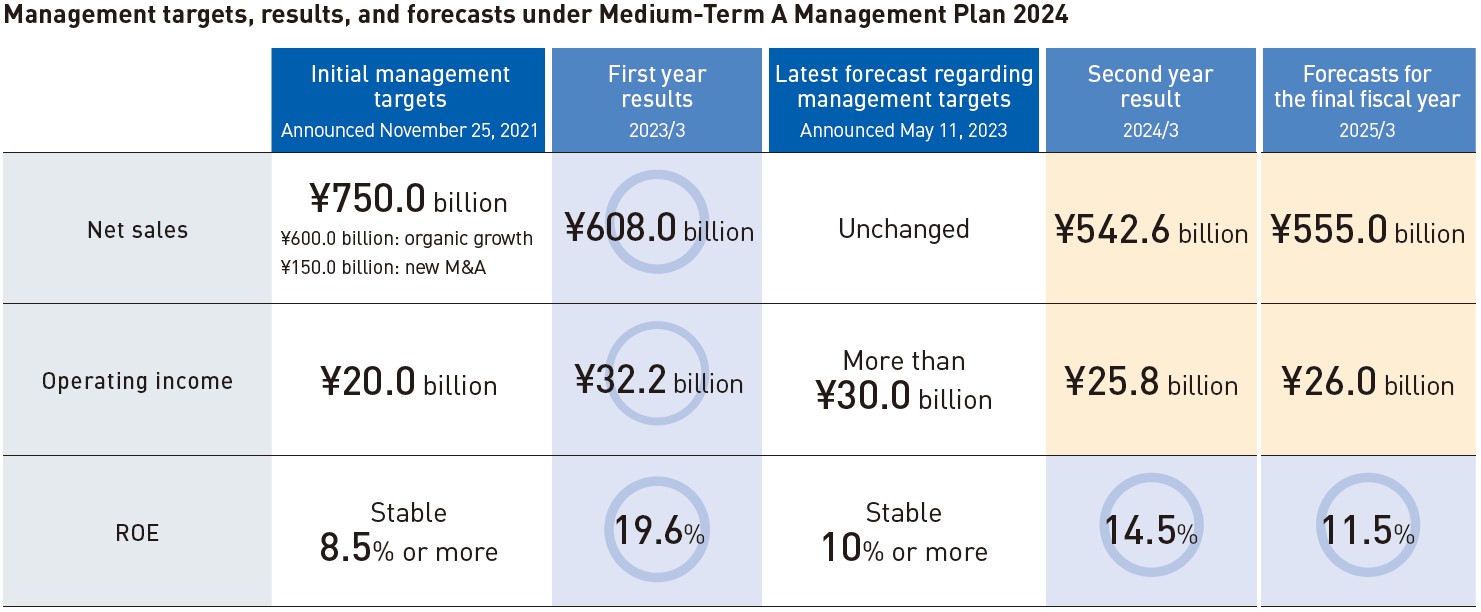
The plan sets out four basic policies: further enhance our earnings power, strengthen management foundations, create new businesses, and promote SDG-oriented management. We elieve that our progress in addressing key issues in line with these policies is generally going to plan.
Regarding efforts to further enhance our earnings power, in April 2024, we were able to start up a new factory in Mexico and thereby strengthen and expand our EMS business and overseas business as a whole. To strengthen management foundations, we proactively invested in human capital. Progress was also made in the use of specialized childcare leave by
male employees, as well as in the implementation of Group-wide wage hikes.
On the other hand, with regard to creating new businesses, we have invested in venture companies through the use of corporate venture capital (CVC), but have yet to identify ppropriate M&As to pursue. This remains an ongoing issue for us.
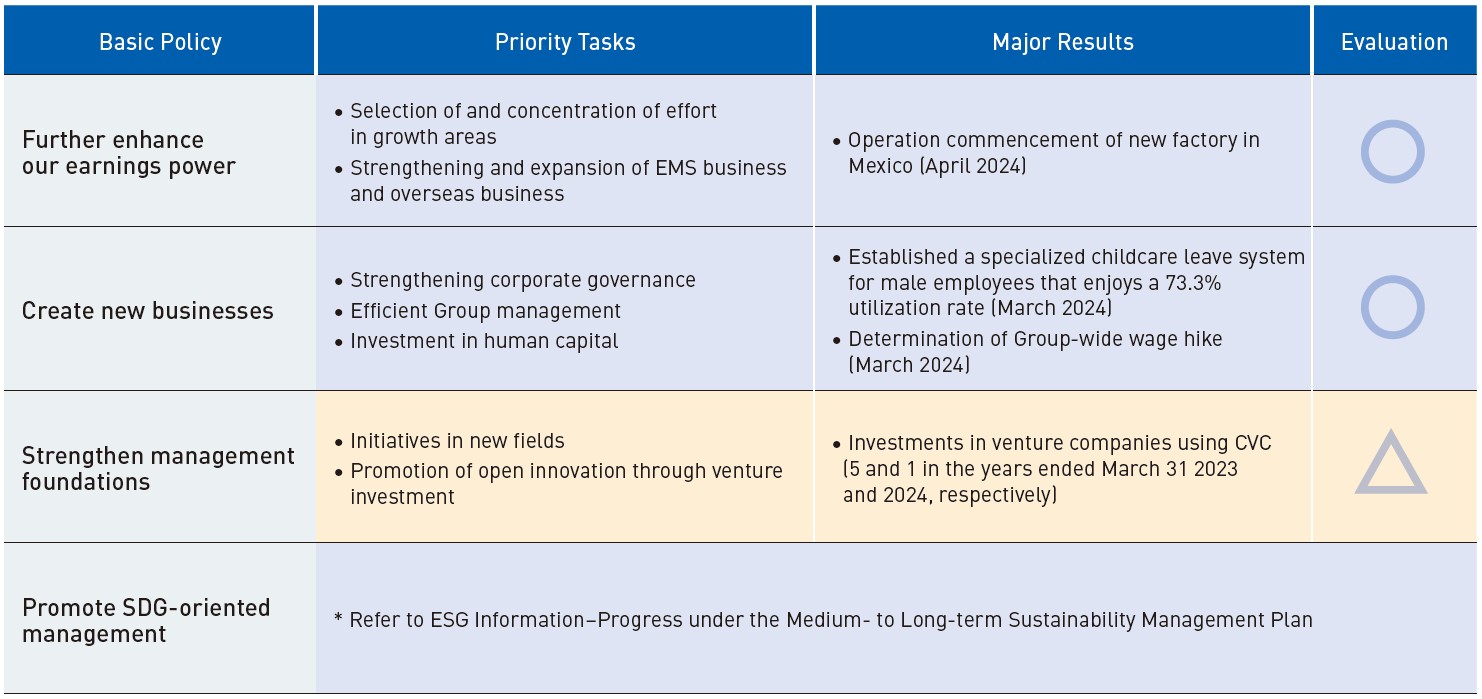
We have begun formulating the next Medium-Term Management Plan , which will start from the fiscal year ending March 31, 2026, aiming to present to our shareholders and investors a growth scenario for the Group as we look ahead to the 60th anniversary of our founding.
Although we hesitate to discuss specifics at this time (September 2024), we intend to upgrade the priority measures set forth in the current Medium-Term Management Plan 2024 hile strengthening our business portfolio management in existing business areas. In other words, we will redefine our business portfolios while determining the trajectory of our medium-term strategy based on the market growth potential and competitive advantages of each portfolio. Since assuming the role of president, I have taken the profit-oriented management that I have been advocating one step further, and I envision using it to promote each portfolio’s businesses in more meaningful and effective ways as well as to inform decisions on business investment and human capital investment. We will also continue to embrace the challenges of M&A and the creation of new businesses that will enable the Group to achieve unconventional growth.
Another key issue to consider is the implementation of capital policies to achieve quantitative management targets through business promotion and to achieve “management with an awareness of capital costs and stock prices.” We are in the process of reviewing our capital allocation policy, which guides how we assign profits and cash earned to investments
for growth and shareholder returns, as well as our current method of determining shareholder returns, which is based on maintaining a dividend payout ratio of 25% to 35%. Please do not miss the details of our next Medium-Term Management Plan , which is scheduled to be announced in November 2024.